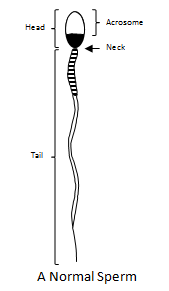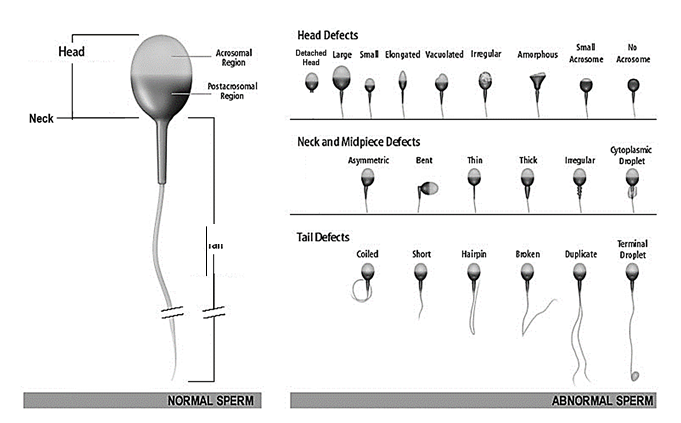We offer free and confidential appointments with a Fertility Nurse. Appointments are for Australian residents only. – CLICK HERE TO REQUEST AN APPOINTMENT
Bulk Billed options available – Learn more
Low sperm morphology (shape or physical appearance of sperm) is not something you want to hear after a semen analysis, however, it happens more often than you might think.
It is quite common for fertile men to have a low percentage of ideally shaped sperm; however when the proportion of ideally shaped sperm has significantly reduced the chance of being fertile is lower. Even though there is a definite trend between normal appearing sperm and fertility potential, this, however, does not mean that a male with a semen analysis result of 0% normal shaped sperm cannot father a child, as we only assess 400 sperm in what often are millions!
Defects in the shape of the sperm neck or tail can affect movement; whilst defects in the sperm head can affect the sperm’s ability to bind to and fertilize the egg. When assessed using the strict World Health Organisation (WHO) criteria, the morphology result is simply a marker of sperm function, which influences the sperm’s chance of fertilizing an egg. It is important to remember that if an egg is fertilized with an abnormal ‘looking’ sperm it doesn’t increase the chance of potential birth defects in any resulting children.
Semen Analyses Assesses Your Sperm
If you are actively trying to conceive with your partner, a semen analysis is the only way to determine what type of sperm you are producing. Given that a semen analysis is a fairly non-invasive procedure, this is often one of the first tests recommended by your Fertility Specialist during fertility investigations.
Sperm morphology is just one thing we assess in a semen analysis. We also look at semen volume, pH, the number of sperm in a sample (concentration), how fast the sperm are swimming (motility) and if the sperm is clumping together (usually due to sperm-producing antibodies after trauma involving the testicles or certain illnesses). Generally, higher numbers of abnormally shaped sperm are associated with other irregularities of the semen such as low sperm count or motility.
What Is A Normal-Shaped Sperm?
- A smooth, oval-shaped head that is 5-6 micrometers long and 2.5-3.5 micrometers wide (less than the size of a needlepoint)
- A well-defined cap (acrosome) that covers 40% to 70% of the sperm head
- No visible abnormality of neck, midpiece, or tail
- No fluid droplets in the sperm head that are bigger than one-half of the sperm head size
How Can A Sperm Be Abnormal?
As seen in the image below, sperm can have multiple defects. These can affect the head, neck or tail region.
Is there anything I can do to improve the shape of my sperm?
Research has shown a relationship between abnormal sperm shape and tobacco, alcohol and caffeine use. While you are trying for a pregnancy, you should not use tobacco or recreational drugs and you should limit your alcohol and caffeine consumption.
These substances may effect sperm DNA (material that carries your genes) quality. It is also important to maintain a healthy weight and ensure you are eating a balanced diet, as this also has an effect on sperm.
We recommend taking Menevit, as it has been shown to improve reproductive health. However, it may take up to 3 months for any changes in diet and lifestyle to become noticeable in sperm sample, as this is roughly the length of the sperm cycle.
Sometimes changes (such as DNA integrity) cannot be assessed with a routine semen analysis. This instead may be evident in tests which look at sperm DNA integrity, such as a Halosperm test.
It takes two to tango!
In addition to semen quality, other factors that can affect the couple’s chance of getting pregnant include:
- * frequency and timing of intercourse
- * the length of time the couple has been trying to conceive
- the age of the female partner
- and the cause of infertility
These factors combined with the semen analysis result will assist the Fertility Specialist recommend which treatment is most suitable for your specific situation.



